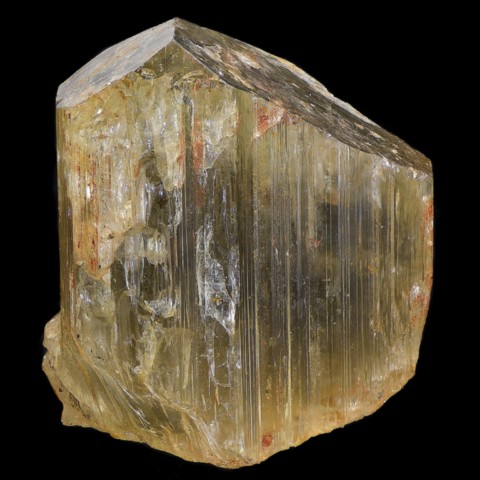MIZZONITE
Class : Silicates
Subclass : Tectosilicates
Crystal system : Tetragonal
Chemistry : (Ca,Na)4(Al,Si)12O24(CO3,Cl)
Rarity : Fairly common
Mizzonite is a mineral belonging to the marialite - meionite series, from the scapolite group, chemically close to feldspars. It is an intermediate term composed of 80 to 50% meionite and 20 to 50% marialite. Like meionite, mizzonite appears mainly in metamorphosed limestones, in skarns and volcanic tuffs. Meionite and mizzonite have long been known from metamorphic limestones released from Italian volcanoes. Its name comes from the Greek meizon (larger), its unit cell parameters being slightly larger than those of meionite. Mizzonite is variable in color : usually yellowish to green, it can be colorless, white, rarely pink or purple. The crystals are prismatic, with an octagonal outline, striated parallel to [001], and very often ending in flattened pyramids ; they can be decimetric in size. Since pure meionite is very rare, it is likely that the "meionite" of many sites is similar to mizzonite and that these two minerals share the same deposits. Some transparent specimens of pale yellow or purple hue are used as gemstone.
Main photo : Mizzonite from Rubeho Mountains, Kilosa District, Morogoro Region, Tanzania © Dan Weinrich
Mizzonite in the World
Twinning
No twin known for this mineral species.
Fakes and treatments
No fakes recorded for this mineral species.
Hardness : 5.5 to 6
Density : 2.5 à 2.62
Fracture : Irregular to conchoidal
Streak : White
TP : Translucent to transparent
RI : 1.532 to 1.550
Birefringence : 0.007 to 0.009
Optical character : Uniaxial +-
Pleochroism : Visible
Fluorescence : Orange, yellow, red
Solubility : Hydrochloric acid
Magnetism : NoneRadioactivity : None


